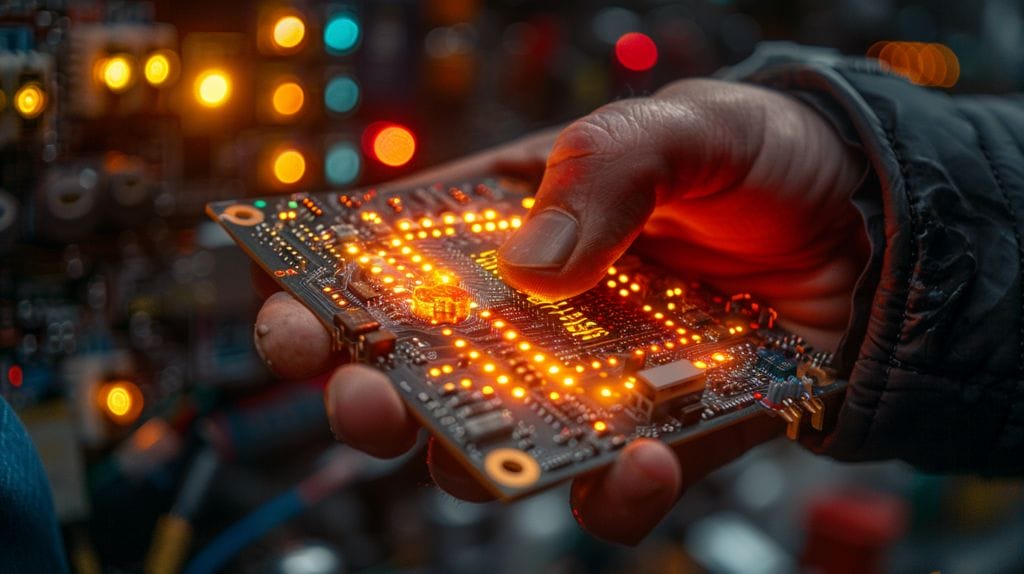Led Light Blinking Circuit: Building a Blinking LED Circuit
Did you know that LED blinking circuits are one of the most popular beginner electronics projects, with a high success rate for enthusiasts?
Building a blinking LED circuit can be a fulfilling endeavor, offering a hands-on experience in understanding circuitry and components.
By starting with a simple transistor-based circuit and progressing to more complex setups involving timers or microcontrollers, you can enhance your skills and creativity in electronic design.
Join us in our Led Light Blinking Circuit guide as we explore the intricacies of LED blinking circuits and unlock the potential for endless innovation in the realm of electronics.
Key Takeaways
- Transistors and capacitors control LED blinking in circuits, forming the base of the system.
- Adding multiple LEDs creates visually appealing blinking patterns, enhancing the visual experience of the device.
- Utilizing a 555 Timer IC allows precise control over blinking rates.
- Microcontrollers enable intricate and customizable LED blinking sequences.
Understanding the Basics of a Blinking LED Circuit

To create an innovative LED blinking circuit, we need to understand the role of each component. Transistors act as the switches that control the flow of current to the LED. Capacitors store and release electrical energy, influencing the timing of the blinking effect. Resistors limit the current to prevent damage to the LED and other components. The LED itself is the light source that will blink on and off.
The power supply plays a crucial role in determining the blinking pattern of the LED. The voltage supplied by the power source affects the charging and discharging of the capacitor, C1, which in turn impacts the timing of the LED blinking, creating a visual effect. By manipulating the power supply voltage, we can adjust the frequency and duration of the LED blinking, allowing for customization and creativity in designing unique blinking patterns, thereby solving the problem of static displays.
Understanding how transistors, capacitors, resistors, LEDs, and power supply interact is key to crafting an engaging LED blinking circuit. By mastering these components, we can experiment with different configurations to achieve the desired blinking effects, enhancing the circuit’s application potential.
Building a Simple LED Blinking Circuit Using Transistors

Exploring how transistors can be utilized to create a simple LED blinking circuit opens up a realm of possibilities for innovative electronic projects. To construct a basic LED blinking circuit using transistors, you’ll need a few key components such as transistors (NPN or PNP depending on the desired configuration), resistors, capacitors, and of course, LEDs.
Begin by setting up the transistor in a configuration that allows it to switch the LED on and off. By controlling the current flow through the transistor using a resistor and capacitor network, you can achieve the blinking effect. One common method is to use a transistor in a multivibrator circuit to make the LED blink at a specific rate.
For those looking to take their project a step further, consider adding two LEDs for an alternating blink effect. This can be achieved by incorporating additional transistors and LEDs into the circuit in a way that creates a visually appealing alternating pattern.
Diving Deeper: Creating a Blinking LED Circuit with a 555 Timer

Constructing a blinking LED circuit with a 555 Timer IC brings a whole new level of versatility to your electronic projects. The 555 Timer IC is a highly popular integrated circuit that can be configured to create various types of circuits are used, one of which is the blinking LED circuit.
To build a blinking LED circuit with a 555 Timer IC, you’ll need to connect the timer in astable mode, which generates a continuous square wave. The frequency of this square wave, and consequently the blinking rate of the LED, can be adjusted using a variable resistor in the circuit. This allows for customization of the blinking pattern to suit your specific requirements, showcasing the device’s versatility in visual applications.
Advancing Further: Blinking LED Using a Microcontroller

Incorporating a microcontroller for enhanced blinking functionality allows us to achieve more intricate LED blinking patterns compared to traditional circuits, broadening the application base. Programming the microcontroller allows us to customize the blinking sequences, durations, and intervals with precision and flexibility.
When working with a microcontroller for LED blinking, power considerations become crucial. The power requirements of the microcontroller, along with the LEDs, need to be carefully managed to ensure stable and reliable operation; incorporating a battery can aid in this. Proper power supply design and management are essential to prevent issues such as voltage drops or fluctuations that could affect the performance of the circuit.
Is the Blinking LED Circuit Similar to the Blinking Pattern of a Smoke Detector?
The blinking LED circuit is not similar to the blinking pattern of a smoke detector. While the LED circuit may have a consistent and rhythmic blinking pattern, a solid green light smoke detector typically indicates that it is functioning properly and is not in need of attention.
Tips and Troubleshooting for a Successful LED Blinking Circuit

To ensure a successful LED blinking circuit, it’s crucial to pay attention to the correct polarity of the diode and LED components. The diode allows current to flow in only one direction, and connecting it backward can prevent the circuit from functioning properly. Similarly, the LED is also polarity-sensitive, and reversing its connections across the LED can lead to it not lighting up in the circuit.
Understanding the role of capacitors in circuit stability is essential. Placing the capacitor in the circuit strategically can improve the blinking pattern of the LED and prevent rapid changes in brightness.
Common issues to look out for when troubleshooting a blinking LED circuit include loose connections, faulty components, or incorrect resistor values. By paying attention to these tips and troubleshooting techniques, you can create a stable and reliable LED blinking circuit for your innovative projects, solving any potential problem.
Conclusion
In conclusion, building a blinking LED circuit can be a fun and rewarding project for beginners and experienced hobbyists alike. Whether using transistors, a 555 timer, or a microcontroller, there are various ways to create a blinking LED circuit across the LED.
With some basic understanding and troubleshooting tips, anyone can successfully create their own LED blinking circuit. Have fun experimenting and creating your own unique LED blink patterns!
Frequently Asked Questions
What is a blinking LED circuit?
A blinking LED circuit is a simple electronic circuit that causes an LED to turn on and off at regular intervals, producing a blinking effect.
What components are needed to build a blinking LED circuit?
To build a blinking LED circuit, you will need components such as LEDs, capacitors, resistors, a power supply, and diodes.
How can I add more than one LED to the blinking circuit?
You can add more than one LED to the blinking circuit by connecting them in series or parallel to the existing LED.
What is the role of a capacitor in a blinking LED circuit?
Capacitors, like C1, are used in blinking LED circuits to control the timing of the blinking effect by storing and releasing electrical energy.
Can I use different voltages to power the blinking LED circuit?
It is recommended to use a low voltage power supply to power the blinking LED circuit to ensure the safety of the components.







